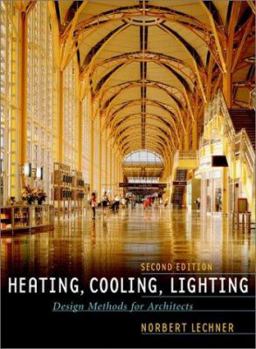Heating, Cooling, Lighting: Design Methods for Architects
Select Format
Select Condition 
Book Overview
The essential guide to environmental control systems in building design For over 25 years Heating, Cooling, Lighting: Sustainable Design Strategies Towards Net Zero Architecture has provided... This description may be from another edition of this product.
Format:Hardcover
Language:English
ISBN:0471241431
ISBN13:9780471241430
Release Date:December 2000
Publisher:Wiley
Length:640 Pages
Weight:3.70 lbs.
Dimensions:1.4" x 8.6" x 11.2"
Customer Reviews
5 ratings
A Great Understanding for the Future of Architectural Design
Published by Thriftbooks.com User , 13 years ago
Being an architecture student, I understand the future of architecture is held in sustainable design. I found this textbook to be an extremely reliable source for my Environmental Systems class. When designing, we now put a greater emphasis on sustainable techniques and how future generations are effected by how we design today. Lechner describes a wide variety of methods that can be used in modern architectural design. The textbook covers everything from basic sunlight integration to complex ventilation strategies. He develops these ideas based off precedent studies and historical influence. He goes into great detail when describing how and why past and future methods can be effective. A nice thing that Lechner does is he describes the pros and cons to many sustainable techniques. It's really nice to see what has worked, and what hasn't. He also summarizes each chapter, allowing the reader to pick up on the most essential ideas. Visual diagrams and images also assist the reader in understanding key components. All of the information presented is well thought out and executed to get the important concepts exposed. It's filled with relatively simple yet effective information anyone can understand. I would absolutely recommend this textbook to anyone, especially if they are looking to grasp a firm understanding of sustainable design strategies.
Great Into book for Architects
Published by Thriftbooks.com User , 14 years ago
I purchased this book for a course I'm taking on Environmental Design. The course is required for my Master's of Architecture (first professional) program. The book is very comprehensive and provides a great amount of information that can IMMEDIATELY start influencing your designs and make them more sustainable. Great book!
Good Book, Easy Read
Published by Thriftbooks.com User , 16 years ago
As a mechnical engineer working on energy efficient buildings, this book enabled me to step back view buildings from an architectural point of view. It is easy to read and understand and delivers relevant basic knowledge. Although there are newer books with more update information this book is a good package delivering the basics.
Great Book
Published by Thriftbooks.com User , 17 years ago
Very informative and easy to read. I picked this book up to study for my Architect's License Exam and found it to be a very well rounded book. There are lots of good ideas for saving energy and good practices for building orientation and construction. There are also plans on how to build a small sun machine for testing your models. My only disappointment were the numerous typos. A good editor could have taken care of that. Otherwise good author, good info. Highly recommended.
Excellent text book for environmental system course and design studio
Published by Thriftbooks.com User , 17 years ago
A very clear and concise presentation of the basic material (as stated in the title) for all architecture, construction science, and interior design undergraduate students. The three tier conceptual approach, presented at the beginning, really helps the students understand the structure of the presentation. The "key ideas" section at the end of each chapter helps the students study for my quizzes too. I have found that the appendices and bibliography are very helpful for graduate students - further study. At the beginning of the semester, an undergraqduate ID student ask me what the relevance of the story about Easter Island had for her. By the time we arrived at the chpaters on "Lighting", she told me she got it. The biggest problem with using this book in a undergraduate lecture course for design students is that the studio instructors can no longer say that the students "said they didn't get" both the sustainability issues and technical information needed to have a strong basic understanding to apply to design thinking. Now they will be forced to invent other reasons for why students are not required to fully integrate by 4th year studio and beyond - and still develop strong conceptual ideas. Among other reference text, I also found that Allen/Iano's "Studio Companion" as a supplement is helpful for further visualizing the HVAC systems and their direct application to building design thinking. The major technical weakness/omission is that it is missing one good chapter dedicated to water - hence the 4 star instead of 5 star rating in my opinion.





